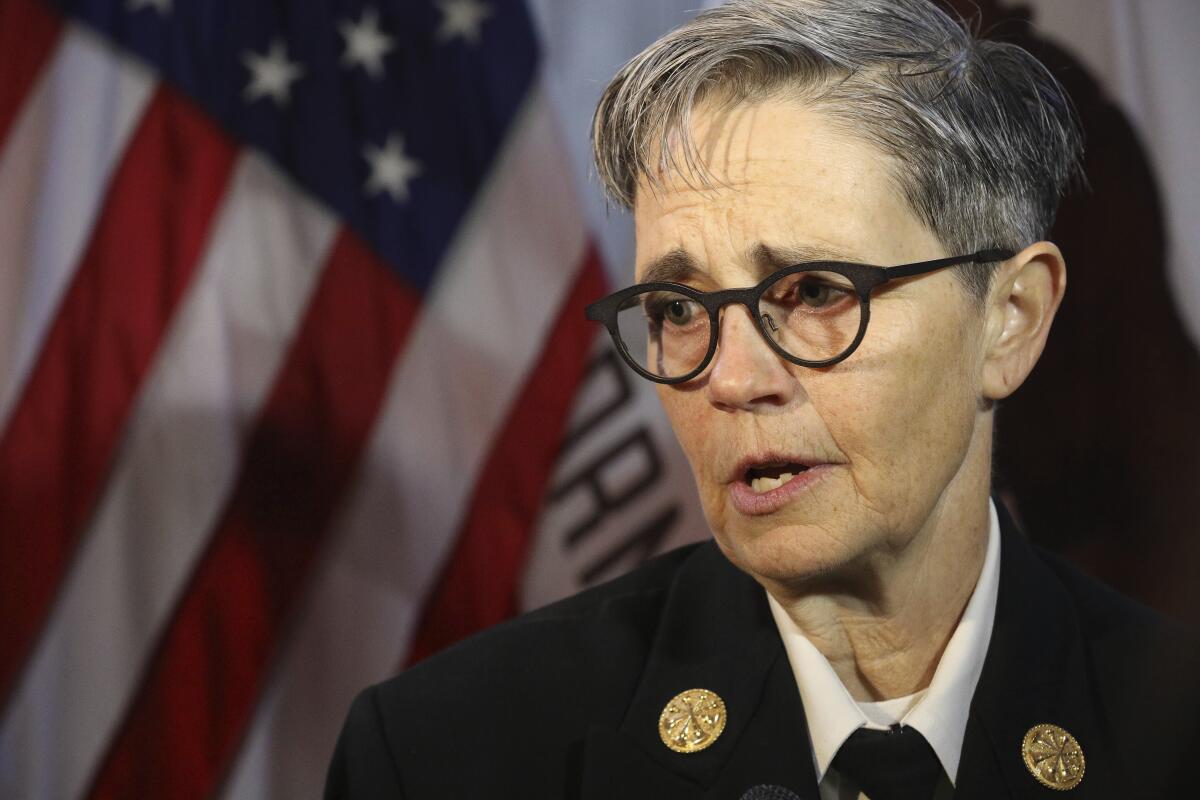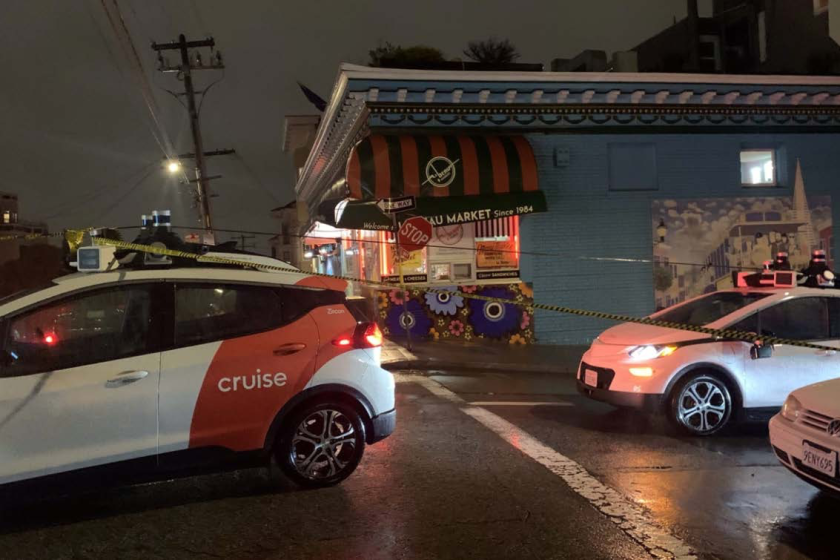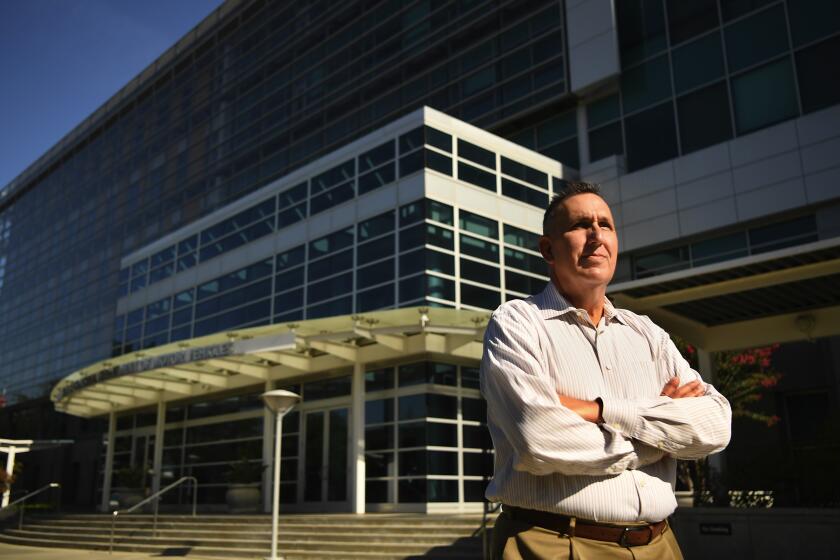San Francisco’s fire chief is fed up with robotaxis that mess with her firetrucks. And L.A. is next

- Share via
Robotaxis keep tangling with firefighters on the streets of San Francisco, and the fire chief is fed up.
“They’re not ready for prime time,” Chief Jeanine Nicholson said.
Nicholson is talking about the driverless taxis from Waymo and Cruise that are picking up passengers and dropping them off in designated sections of the city. Now those companies want to rapidly expand service throughout the entire city, in unlimited numbers, in any kind of weather, day or night. And state regulators appear ready to approve their request.
City leaders are worried — not only in San Francisco, but in Los Angeles and Santa Monica, too, where Waymo and another robotaxi company, Motional, say they’re ready to deploy their AI-operated robotaxi service as soon as state regulators flash the green light.
The robotaxi industry is being allowed to move too fast and break things, these officials say, putting more robotaxis on public streets even as they prove inept at dealing with firetrucks, ambulances and police cars. And, they say, California state agencies have set up the rules so cities have little say in autonomous vehicle regulation.
“I’m not against the technology. I understand it’s important and it’s the way the industry is going,” Nicholson said. “But we need to fix what’s not working right now, before they are unleashed on the rest of the city.”
San Francisco officials want to delay a vote on robotaxi expansion while issues with emergency vehicles are sorted out.
State regulators track robotaxi collisions, but they don’t track data on traffic flow issues, such as street blockages or interference with firetrucks.
But the Fire Department does. Since Jan. 1, the Fire Department has logged at least 39 robotaxi incident reports.
Although, as the driverless industry notes, robot cars don’t get tired, don’t drive drunk or high, and aren’t distracted by their iPhones, they do often stop dead in traffic for no apparent reason. Sometimes these robo-roadblocks are brief, but sometimes the road obstructions last long enough to require a robotaxi company employee to travel to the scene and move the car out of the way.
The Fire Department incidents include reports of robotaxis:
- Running through yellow emergency tape and ignoring warning signs to enter a street strewn with storm-damaged electrical wires, then driving past emergency vehicles with some of those wires snarled around rooftop lidar sensors.
- Twice blocking firehouse driveways, requiring another firehouse to dispatch an ambulance to a medical emergency.
- Sitting motionless on a one-way street and forcing a firetruck to back up and take another route to a blazing building.
- Pulling up behind a firetruck that was flashing its emergency lights and parking there, interfering with firefighters unloading ladders.
- Entering an active fire scene, then parking with one of its tires on top of a fire hose.

After a mass shooting June 9 that wounded nine people, a robotaxi blocked a lane in front of emergency responders in the city’s Mission District. Another lane was open, but in a news release, the Fire Department said on a narrower street, the blockage could have been “catastrophic.”
To deal with a troublesome robotaxi, firefighters attempt to communicate with a remote robotaxi operator, who sometimes can move the car out of the way.
If that proves impossible, the robotaxi company must dispatch a human to the scene. In one case, a firefighter had to smash through a window to coax a robotaxi to move out of the way.
‘Dealing with life and death’
The fire chief said each robotaxi company offers training to help deal with “bricked” vehicles.
“We have 160,000 calls a year. We don’t have the time to personally take care of a car that’s in the way when we’re on the way to an emergency,” she said.
Hannah Lindow, spokesperson for Cruise, said the company is “proud of our publicly reported safety record which includes driving millions of miles in an extremely complex urban environment. Interacting properly with emergency personnel is important to us, which is why we maintain an open line of communication with first responders to receive feedback and discuss specific incidents to improve our response.”
While regulators investigate a spate of Teslas steering themselves into parked vehicles, Tesla owners have been reporting faulty collision-avoidance systems.
Waymo issued a prepared statement: “Safety is at the heart of our mission and we have consistently shared more detail than any other [autonomous vehicle] company regarding our methodologies and insights into our performance. We believe this transparency benefits our riders — who are enjoying a safe, accessible, and delightful mobility option tens of thousands of times per week — and encourages a richer conversation about safety in the industry.”
Nicholson acknowledged that no one has yet been killed or injured due to robotaxi misbehavior. “But I don’t want something bad to happen because we can’t get to a scene. A fire can double in size in a minute. We are dealing with life and death, and I’m not being dramatic in saying that.”
The robotaxi industry in California comes under the jurisdiction of two state agencies — the Department of Motor Vehicles, which issues permits and is responsible for safety, and the California Public Utilities Commission, which regulates commercial passenger service, including buses, taxis and limousines.
The utilities commission is set to vote on robotaxi expansion June 29. The resolutions it will vote on make clear that, under the agency’s own rules, issues such as traffic flow and interference with emergency workers can’t be used to deny expansion permits. The resolutions list four “goals” to be considered: inclusion of people with disabilities; improved transportation options for the disadvantaged; reduction of greenhouse gases; and passenger safety.
Critics note that although the commission concerns itself with the safety of robotaxi passengers, it defers other safety issues to the DMV. The DMV collects data on collisions and has the power to suspend permits, but so far has taken no action or made any statements about robotaxi interference with firefighters.
The DMV declined to make its director, Steve Gordon, available for an interview, but issued a statement suggesting that its 4-year-old rules might be open to amendment at some point: “The DMV developed its autonomous vehicle regulations using a public process whereby stakeholders (e.g., local, state, federal government agencies, academia, interest groups, industry representatives) provided input in the development. Comments provided during this process were considered and addressed as part of the rulemaking in the Final Statement of Reasons. The DMV implemented the first set of regulations in 2014, the second in 2018 and the third in 2019. Any future regulations will use a similar process where members of the public and other stakeholders will be invited to participate and provide comments.”
Why doesn’t the DMV have anything to say about its investigation of Tesla’s autonomous driving claims after a full year? The agency isn’t talking, and lawmakers are getting impatient.
Robotaxi regulation issues go beyond robotaxi expansion: The entire way in which California regulates autonomous technology is being questioned.
The DMV has come under fire in the state Assembly, which passed a bill in May that would take away some of the agency’s power to regulate driverless big-rig trucks. Several legislators said they voted in favor of it in part because they believe the DMV has done a poor job of regulating driverless cars.
Safety data censored
In 2021, the DMV joined with Waymo on a court-approved deal to allow driverless car companies to censor not only trade secrets but basic information on safety performance, including most details of collision reports as well as information on how the company handles driverless car emergencies.
The industry is tight with the information it releases to the public about its operations on public roads.
Waymo won’t say how many cars it runs in San Francisco. Cruise said it operates 150 to 300 cars but won’t be more precise. Neither company will say how large its fleet will grow, or how quickly. Neither Waymo nor Motional will say how many robotaxis they’re testing in Santa Monica and L.A.
City officials in San Francisco, a notoriously fractious bunch, are united in opposing the expansion plan, from Mayor London Breed on down, until traffic flow, emergency scene problems and better communications between the companies and the city are worked out.
“Usually the mayor is on the side of corporations and the supervisors are on the other side,” said Board of Supervisors member Aaron Peskin. “We’re saying, don’t give them everything they want until these things are proven. Don’t make us the guinea pigs.”
Waymo, Google’s robotaxi spinoff, has come to Los Angeles. What happens when autonomous vehicles invade the traffic capital of the country?
The fire chief wonders why the ability to deal with emergency scenes was not made a high priority.
“If they can do all this stuff with AI, I’m sure they can figure this stuff out,” Nicholson said.
The utilities commission has gathered expressions of support from dozens of groups that include business organizations, such as the Silicon Valley Leadership Group, and advocates for the disabled, such as the American Council for the Blind. The former argue that robotaxi development is essential to keep California at the forefront of innovation, the latter make the case that easy and equitable transportation for all people is a social good that will benefit everyone. No one on any side of the debate has disagreed with either assertion.
But agencies including the Los Angeles Department of Transportation and the city of Santa Monica have filed comments with the commission arguing that robotaxi service should be rolled out incrementally as problems are identified and addressed. Both also called for far more data transparency on robotaxi safety issues.
The industry countered with filings opposing any kind of incremental rollout.
What’s the rush? Robotaxi companies have spent enormous sums developing expensive artificial intelligence technology and want a return on investment.
Cruise, owned by General Motors, has deep pockets. Waymo, owned by Google’s Alphabet, deeper still. But the pressure’s on. In October, Ford and Volkswagen shut down Argo, their robotaxi joint venture, after concluding they’d see better returns investing that money in electric cars and driver-assistance and safety systems.
The utilities commission’s robotaxi expansion measure was slated to be considered as part of a June 29 “consent agenda” package that will gather 50 orders and resolutions on a wide variety of issues, to be passed or rejected by a single vote by the agency’s five commissioners. After this story published, the vote was delayed until July 13.
One of those commissioners, lawyer John Reynolds, was appointed by Gov. Gavin Newsom in 2021. At the time, he served as general counsel for Cruise.
More to Read
Inside the business of entertainment
The Wide Shot brings you news, analysis and insights on everything from streaming wars to production — and what it all means for the future.
You may occasionally receive promotional content from the Los Angeles Times.














